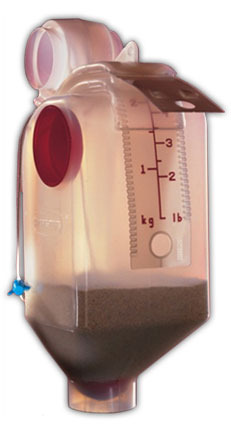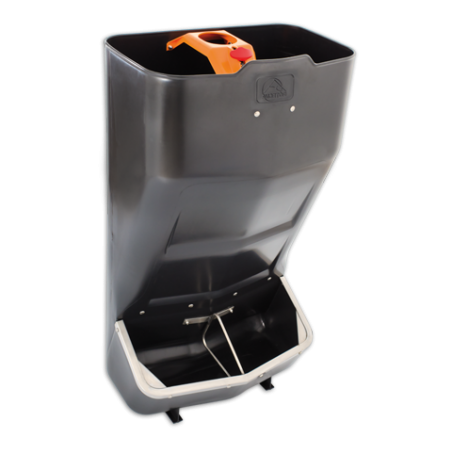Introduction
The feeds for sows are normally in meal or pelleted form, and the crumble form is not as common. Pelleting has a cost, so the use of pellets instead of meal is a financial decision that must be justified by the advantages provided.

In general, pelleted feed provide better yields than meal. During the fattening period the improvement is about 5-6% of the FCR and the ADG. The main reasons are:
- Less feed waste.
- Lower segregation of the ingredients.
- Slight improvement in digestibility.
- Improvement in palatability.
- Reduction of the microbial load.
- Increase in density and decrease in its variability.
In sows there are few experimental evidences when comparing the results of feed in pellet or meal form. In general, the majority of the previously mentioned benefits would also be applicable to sows to a greater o lower extent.
Whatever the feed form, its grinding is important. The finer it is, the better digestibility of the feed and the lower dry matter and nitrogen excretion. The problem is that the smaller the particle size the higher risk of ulcers and the higher grinding costs. Bearing in mind all these factors, the grinding of the feed must yield a particle size of about 600-700 microns.
During lactation
It is well known that the higher the feed consumption during the nursing period the lower the loss of body condition of the sow, the better the production in the following breeding cycle, and the higher the milk production, and therefore the better the growth of the litter.
So, all the nutritional and handling strategies that attain an improvement in the consumption of feed during the lactation period or a better digestibility will result in an improvement in productivity.
Pellet vs. meal
One of the most frequent recommendations for improving the feed consumption of sows during lactation is to use pellets instead of meal. Nevertheless, this is not supported by experimental evidences.
In a study at Kansas State University (Baudon and Hancock, 2003), the pelleted feed reduced the backfat loss in the sows, it improved the digestibility of energy, nitrogen and dry matter and, therefore, it reduced the excretion of nitrogen and dry matter. Nevertheless, it did not improve the sows' consumption nor the growth of the litters.
In a similar test carried out by our company in 2012 in Canada, the pelleted feed neither improved the consumption during lactation nor the growth of the litter. Nevertheless, the pelleting improved the efficiency of the feed in terms of a better FCR in terms of kg of sow lactation feed/kg of growth of the litter (-0.11), and of a lower weight (2.6 kg) and backfat (0.5 mm) loss in the sows.
Wet or dry feed
A very effective method for improving the feed intake of the sow during lactation is to give the feed mixed with water. The feed intake increase can be aroung 10%: +12% O’Grady and Lynch (1978), +11% Koketsu (1994), and +7% Lynch (2001).
 Illustration 1. Feed dispenser with adjustment scale in kg and lb. |
Recently, Peng et al. (2006) compared the performance of sows fed with a dry feed hopper with a nipple drinker in which the sow was able to moisten the feed at will vs. the ad lib feeding supplied by the farmer 2 times per day in a trough with a bowl drinker away from the trough. The feed consumption of the sows with the hopper was 9% higher, they gained more weight during the lactation (6.2 vs. 0.6 kg), and the weight of the piglets at weaning was half a kilo higher (6.63 vs. 6.12 kg). Although the water consumption was equal in both cases (17.2 vs 17.4 l/day), the water waste was reduced (15 vs. 232 litres) during the 20-day lactation.

During pregnancy
Once the feeding curve for a pregnant sow has been established, the most important thing is to be able to supply the amount of feed needed with the highest possible precision.
The majority of the feed supply systems for pregnant sows are volumetric: this is, the sow eats the feed contained in a container that has a certain volume. These containers have a scale with which the volume (and accordingly, the kg) of feed that they contain can be regulated.
The density of the feed is not constant along time, and it can vary from one shipment to another according to the formulation or the processing of the feed. The density variations may be so ample as the ones shown in the table, that shows the extreme ranges that can be found in feeds in meal and pellet form. This entails that a 7 litre dispenser would have a capacity for 3.15 kg of meal with a density of 0.45 kg/l and of 4.2 kg of pellets with a density of 0.6 kg/l.
Table 1. Kg of feed that fit in a feed dispenser depending on its capacity (liters) and on the feed density.
| kg/litre feed | Litres (dispenser) | ||||
| 5 | 6 | 7 | 8 | ||
| Meal | 0.4 | 2.00 | 2.40 | 2.80 | 3.20 |
| 0.45 | 2.25 | 2.70 | 3.15 | 3.60 | |
| 0.5 | 2.50 | 3.00 | 3.50 | 4.00 | |
| Pellet | 0.55 | 2.75 | 3.30 | 3.85 | 4.40 |
| 0.6 | 3.00 | 3.60 | 4.20 | 4.80 | |
| 0.65 | 3.25 | 3.90 | 4.55 | 5.20 | |
So, it is necessary to check the possible density variations in each feed shipment and to readjust the dispensers in case that the density has changed. The method is very simple: you only have to fill a 1-litre container with feed and weigh it. Then, if the density of the feed has increased by 8%, the dispenser will have to be readjusted towards an 8% less so the sows keep eating the same amount of feed.
An additional problem in many farms is that the dispensers are too small for all the feed that a sow can eat at the end of its pregnancy or during its lactation, so it is necessary to give them 2 meals during pregnancy or 3 during lactation. In these cases the use of pelleted feeds can avoid this problem thanks to their higher density.




